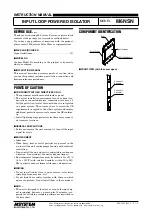
2019.10.25
TP, rev13
Side
3
af
4
This equipment has been tested and found to comply with the limits for a Class B digital device,
pursuant to part 15 of the FCC Rules. These limits are designed to provide reasonable
protection against harmful interference in a residential installation. This equipment generates,
uses and can radiate radio frequency energy and, if not installed and used in accordance with
the instructions, may cause harmful interference to radio communications. However, there is no
guarantee that interference will not occur in a particular installation. If this equipment does
cause harmful interference to radio or television reception, which can be determined by turning
the equipment off and on, the user is encouraged to try to correct the interference by one or
more of the following measures:
- Reorient or relocate the receiving antenna.
- Increase the separation between the equipment and receiver.
- Connect the equipment into an outlet on a circuit different from that to which the receiver is
connected.
- Consult the dealer or an experienced radio/TV technician for help.
Instructions
Only Anticimex service technicians are allowed to install, replace damaged units, and service
installations. Replace the Smart Connect Mini or Smart Eye Mini if the device is faulty.
To install the Smart Connect Mini system the operator must possess a mobile device such as a
smartphone or tablet with access to an internet connection. To install, the operator should have
a user in the Anticimex-
owned software system “Smart Device Tool”.
1.
Use Smart Device Tool to initiate an installation
2.
Scan the QR-code of the Smart Connect Mini
3.
Apply power to the Smart Connect Mini and await green flashes of the gateway,
indicating beacon mode is active: You can now start to set up the sensors
a.
Start setting up sensors closest to the gateway
4.
Push the button of the sensor and await green flashes, indicating connection
5.
Continue to set up all the sensors of the installation in the same way
6.
When all sensors have been installed, end the installation through Smart Device Tool
a.
During this step, the installation will form its mesh and pair sensors
7.
If the connection has formed without any problems, the installation is complete
8.
If there are problems, investigate using Smart Device Tool which sensors did not
connect: Either relocate them or adjust the installation by adding an extra sensor to
solve the problem
9.
End installation through Smart Device Tool.






















